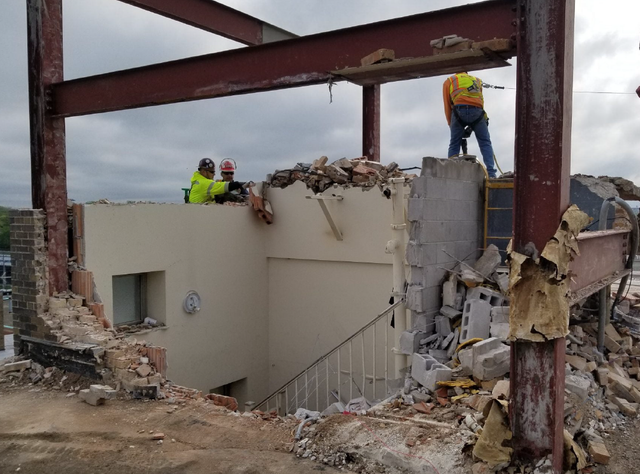The Ultimate Guide to Interior Demolition Techniques and Equipments
Within the world of interior restorations, the art of demolition is a critical phase that needs precision, skill, and the right collection of tools. Whether you are an experienced specialist or a do it yourself fanatic, comprehending the complexities of interior demolition methods can make all the difference in attaining an effective project outcome. As we browse through the subtleties of this extensive overview, we will certainly discover vital tools, precaution, and professional techniques that are crucial when getting started on the journey of transforming a space. Keep tuned to find the vital insights that can boost your demolition expertise to brand-new heights.
Essential Indoor Demolition Devices
When embarking on indoor demolition projects, having the proper devices is important for effectiveness and safety and security. Among one of the most crucial tools for interior demolition is the demolition hammer. This heavy-duty device is made to appear difficult materials like concrete, ceramic tile, and drywall. Its powerful hammering action can quickly demolish walls, floors, and other structures. Furthermore, a crowbar is vital for eliminating fixtures, trim, and other products. Its leverage enables the simple removal of nails and other fasteners without damaging the surrounding surfaces - interior demolition.
Its ability to make precise cuts in limited spaces makes it ideal for demolition work. Generally, having these vital indoor demolition tools will substantially improve the effectiveness and security of any type of demolition task.

Security Preventative Measures Throughout Demolition

In addition, all employees associated with the demolition process ought to receive sufficient training on the appropriate handling of tools and devices to lessen mishaps. It is vital to safeguard the workplace by erecting obstacles and indicators to stop unapproved access - interior demolition. On a regular basis examining and keeping devices and tools can likewise add to a much safer working environment. By adhering to these safety preventative measures, indoor demolition jobs can be performed efficiently while focusing on the wellness of all individuals involved.
Methods for Getting Rid Of Walls
Implementing appropriate safety and security precautions throughout interior demolition jobs is crucial for producing a secure workplace, and one vital element of such tasks includes understanding strategies for removing wall surfaces. One commonly utilized approach is hands-on demolition, which calls for using fundamental hand devices such as sledgehammers, crowbars, and utility knives to thoroughly dismantle the wall surface piece by item. This method permits higher control over the demolition procedure, especially in delicate locations where precision is crucial.
For larger, extra complex walls, mechanical demolition might be necessary. This includes utilizing hefty equipment like excavators or bulldozers to tear down wall surfaces efficiently. It is important to guarantee that the structural integrity of the building is not compromised during mechanical demolition.
Another technique for removing walls is deconstruction, where the wall is disassembled in such a way that preserves reusable materials. This lasting strategy is eco pleasant and can additionally aid lower disposal costs. Whichever strategy is utilized, it is necessary to follow appropriate security protocols and think about the structural implications of wall surface elimination to make sure a successful interior demolition project.
Removing Floor Covering Like a Pro
Successfully getting rid of floor covering throughout interior demolition needs the appropriate devices and strategies to make certain a successful and smooth process. The initial step in removing flooring is to get rid of the area of any furnishings or challenges. Next off, determine the sort of flooring to establish the suitable removal method. For wood or laminate flooring, beginning by getting rid of the walls and after that use a floor covering scrape to lift and detach the slabs. Rug removal entails cutting the carpeting right into manageable sections and rolling it up for disposal. For floor tile or vinyl flooring, a chisel or flooring scraper can be made use of to tear up the ceramic tiles or sheets. It's necessary to put on safety equipment such as gloves, goggles, and a mask to prevent injuries and direct exposure to dirt and debris. Furthermore, having a dumpster or assigned disposal location prepared for the removed floor covering materials is vital for preserving a tidy work environment. By complying with these techniques and making use of the right tools, getting rid of flooring like a pro can be attained effectively and efficiently.
Appropriate Garbage Disposal Techniques
After effectively removing flooring using the appropriate tools and strategies, the following critical action in the indoor demolition process is executing proper waste disposal approaches. Correct garbage disposal is necessary for preserving a risk-free and clean work environment throughout and after demolition. One of the main techniques for waste disposal is segregating materials into different classifications such as recyclable, harmful, and basic waste. This partition guarantees that products are disposed next of appropriately and responsibly.

Service providers must follow local regulations concerning waste disposal to prevent penalties and fines. Utilizing professional waste management services can improve the disposal process and guarantee compliance with environmental standards. By executing proper garbage disposal methods, indoor demolition projects see post can be finished successfully and sustainably.
Conclusion
In verdict, interior demolition calls for the use of essential devices and strict safety and security preventative measures to make sure a successful and safe process. By following these guidelines, interior demolition can be finished effectively and with marginal risks.
One of the most critical devices for indoor demolition is the demolition hammer (interior demolition). Generally, having these important indoor demolition devices will substantially improve the performance and safety of any type of demolition job
Successfully eliminating floor covering during interior demolition calls for the appropriate devices and strategies to make sure a successful and smooth process.After successfully removing flooring utilizing the ideal tools and methods, the following crucial step in the indoor demolition procedure is implementing appropriate waste disposal approaches.In conclusion, interior demolition calls for the use of vital devices and rigorous browse this site safety precautions to guarantee a safe and successful procedure.